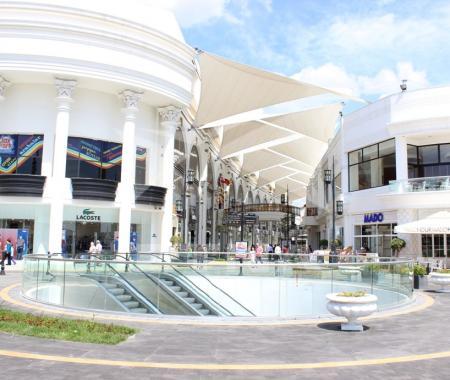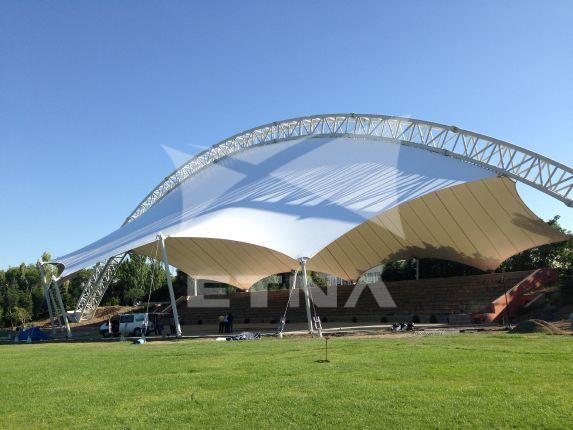Tensile Structure
The classification of tensile structures are made on the plane in which the tensile forces are acting in the structure. On this basis, the tensile structure are divided into following types.
1. Linear Tensile Structures
Linear tensile structures are the structure in which the all the member are in linear tensile forces. This linear members are supported by the compression members , but the major loads are carried out by tensile members. Common example of these structure is cable suspended bridges. The main pillars acts as compression members, but the whole load is carried out by the cables which are in tension.
Linear tensile structures are further classified into following types,
- Suspension bridges
- Draped cables
- Cable-stayed beams or trusses
- Cable trusses
- Straight tension cables
2. Three-dimensional Tensile Structures
Three-dimensional tensile structures, is a compilation of elements that are primarily in tension, with the compression being transferred to a central mast and down into the ground. The most common occurrence of three-dimensional tension can be seen at sports arenas and usually serve as roofs for these structures.
Three-dimensional tensile structures are further classified into following types,
- Bicycle wheel (can be used as a roof in a horizontal orientation)
- 3D cable trusses
- Tensegrity structures
3. Surface-Stressed Tensile Structures
Surface-stressed tensile structures are same as other 2 tensile structure, but the surface members are tension bearing members. Fabric tensile structures are the great examples of Surface-stressed tensile structures, where the vertical pillars hold the special deisgned fabric which is in tension. Surface-Stressed tensile structures are further classified into following types,
- Fabric structure
- Prestressed membranes
- Pneumatically stressed membranes
- Gridshell
Shapes of Tensile Structures
The four basic shapes used in the tensile structures are,
1. Conical Tension Structure
Highly effective for covering large areas, a conical tension structure is easily identified by its tent-like shape. Conical designs can feature either single or multiple masts. For both design options, membranes are tensioned between a ring at the pinnacle and the lower perimeter support columns. Cones are especially effective in areas that need to comply with high rain or snow load regulations.
2. Hypar or Anticlastic Structure
As one of the most common of all tensioned membrane structures due to its aesthetically pleasing look, hypar (hyperbolic paraboloid) shapes are notable for their excellence with shape retention and water runoff. These structures rely on two opposing curvatures, also known as anticlastic, for their stability. This type of structure is ideal for shade over seating areas or high traffic walkways.
3. Parallel Arch or Barrel Vault Structure
These symmetrical curved parallel arch designs form an incredibly functional tensioned membrane canopy that can span long distances such as a sports arena or smaller areas such as an entryway. Depending on the spans, a barrel vault system can be a very cost-effective way to incorporate tensile membrane on a project due to the repetitive nature of the design and efficiencies of materials.
4. Cable Net & Membrane Structure
For long-span tensile membrane roofing applications typically found in stadiums or large spaces, 3D cable net or cable grid structures are an efficient solution for lightweight tensile architecture.
Advantages of Tensile Structures
- Shelter of environment (sun, rain, wind)
- Translucency in general, possibilities to design light effects
- Light weight & Durability
- Endless form possibilities, catching character
- Short building time, off site manufacturing of structure, less site interruption time
- Large spans
- Recyclability and Eco friendliness
- Adaptability to exciting building technologies (steel, glass, cement, stone)
- Simplicity of maintenance & Easy repair or replacement

HISTORY OF TENSILE STRUCTURE
The history of tensile membrane systems has a history that reflects the evolution of lightweight and flexible structures used in architecture and engineering. Although such structures have gained popularity as a result of innovations in modern architecture, their origins date back to ancient times. Here are some highlights of the history of these systems:
Ancient and Medieval Periods
– Antiquity: The principles of hanging and stretching have been used since time immemorial. For example, the Assyrians, Romans and Greeks used techniques of stretching fabrics for awnings and shades. These were often used to provide shade in marketplaces or public areas.
– Middle Ages: The principles of hanging and stretching can be seen in circus tents and travelling marketplaces. These structures were practical as they were portable and lightweight and could be erected in different locations.
20th Century: Innovations in Modern Architecture
– 1920s and 1930s: The emergence of tensile systems in modern architecture dates back to the 1920s and 1930s. The work of Frei Otto, an architect and engineer in Germany, is a pioneer in this field. Inspired by nature, Otto aimed to achieve maximum structural efficiency with minimum material. He pioneered the use of lightweight structures and tensioning systems in architecture.
– 1960s and 1970s: Frei Otto’s research and designs became recognised worldwide, especially with the German Pavilion at the 1967 Montreal Expo and the tent structures for the 1972 Munich Olympic Stadium. These projects demonstrated the aesthetic, functional and engineering potential of tensile membrane systems.
Late 20th Century and 21st Century: Development and Expansion
– 1980s and 1990s: Suspended tension membrane systems became even more popular with the development of modern materials and technologies. The use of innovative materials such as polymer coated textiles, PTFE (Polytetrafluoroethylene) coated glass fibre and ETFE (Ethylene Tetrafluoroethylene) increased the durability and flexibility of such structures.
– 21st Century: Today,tensile membrane systems are widely used in stadiums, airports, shopping centres and other large-scale projects. These systems are favoured for their aesthetic appeal, light weight, energy efficiency and sustainability.
Summary
Tensile membrane systems are a type of structure with origins dating back to ancient times, but shaped by developments in modern engineering and material sciences. Developed under the leadership of architects such as Frei Otto in the 20th century, these systems have an important place in architecture by offering both aesthetic and structural advantages.


